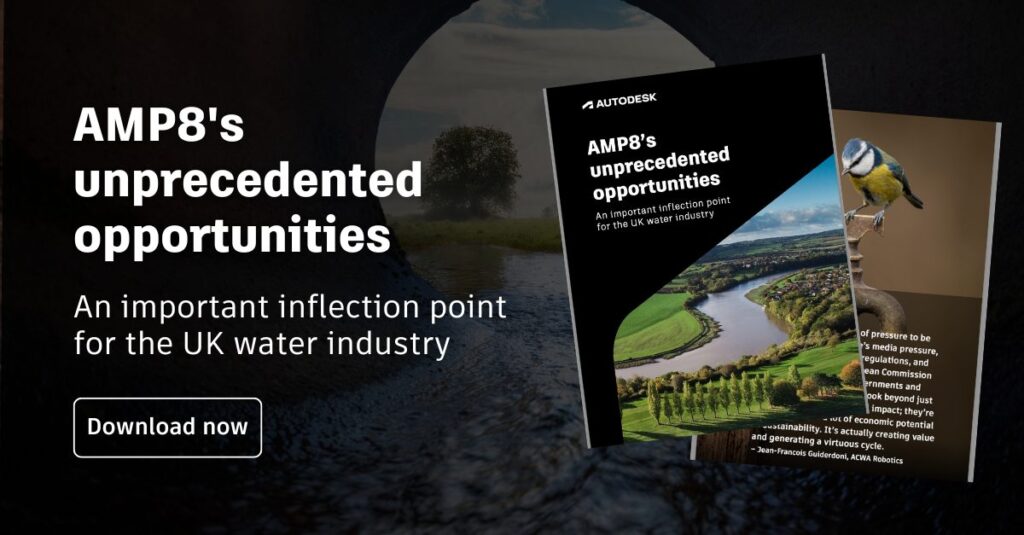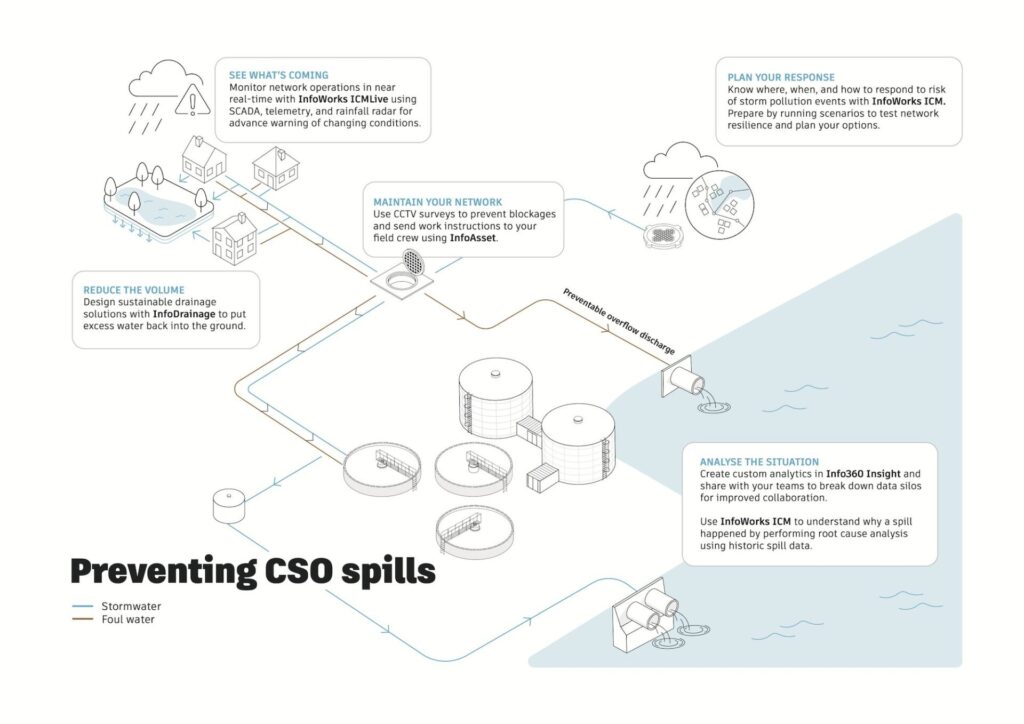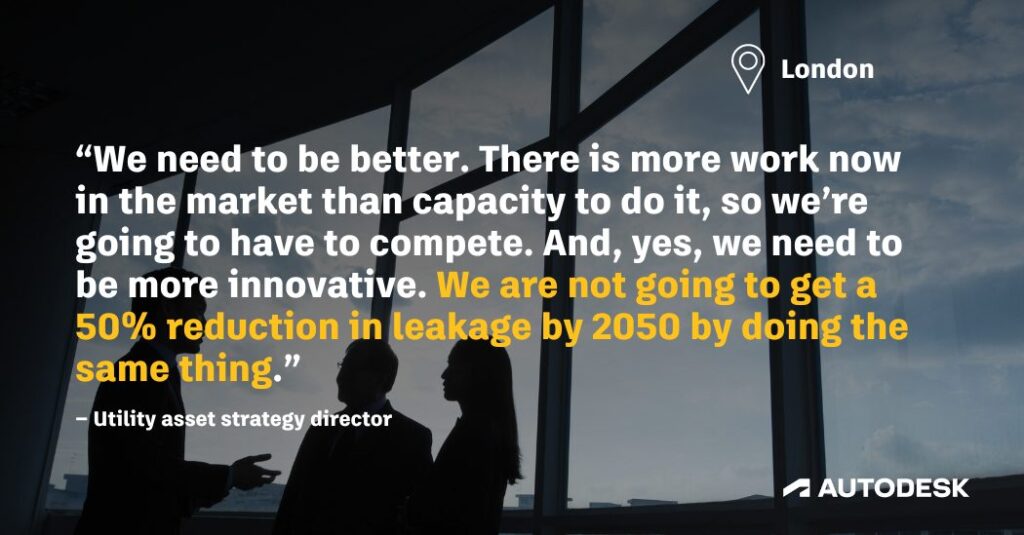& Construction

Integrated BIM tools, including Revit, AutoCAD, and Civil 3D
& Manufacturing

Professional CAD/CAM tools built on Inventor and AutoCAD
8 min read
The recent AMP8 funding cycle is perhaps the best chance for water providers to secure funding for changing the way they monitor and solve for CSOs. We’ve written about it in our new white paper, AMP8’s unprecedented opportunities, a portion of which we’re excerpting here on the One Water Blog.

One of the biggest and most impactful changes in the UK water industry has already been set into motion. The Environment Agency has required all water companies to install Event Duration Monitors (EDMs) on all CSOs, which was completed at the end of 2023. Going forward, EDMs will monitor CSOs every two or 15 minutes, depending on the sensitivity of the receiving water, and EDM data will be collected in an online National Environment Data Hub that will be publicly available for anyone to access.
We strongly recommend that you work to add this sensor data into your hydraulic models. Plugging this EDM sensor data directly into InfoWorks ICM can help you identify your most high-risk CSOs and start solving for them. If a problematic location is subject to a high frequency of spills, you can help find solutions to that problem with a digital model.
You can assess network options that mitigate the risk of CSO spills in various ways. Having a model that enables you to try different options, such as reducing inflows, adding additional storm tanks, upsizing of pipe capacity and uprating of pumps, can help utilities find the most cost-effective ways of ensuring that the network can continue to deliver the service required, without the risk of incurring possible regulatory fines associated with CSO spills.

The impact of stormwater separation using SuDS can also be modelled.
Your newly updated models, with the latest EDM data, can then be used to present both traditional designs and SuDS-based solutions for stakeholders to consider. We believe that including both traditional options that your stakeholders normally choose but also offering multiple SuDS-based options alongside the “usual” options can help make your SuDS-based arguments more attractive. By doing this, you can show stakeholders the gaps that exist between traditional and SuDS-based benefits and associated costs, over both the short and long term, providing them with good reasons to choose new and better designs.
As noted, almost every storm overflow should now be monitored by an Event Duration Monitor, which in a few months should be available for public review via the upcoming National Environment Data Hub. While some may grumble about the inconvenience of being tasked with paying attention to new regulations, smart water professionals will immediately see that this new source of data from EDMs has huge potential. As with any new source of data, it’s important to think creatively about how you might employ that data for other purposes.

These EDM devices can bring a new urgency to your hydraulic modeling simulations. You can import the EDM data into an InfoWorks ICM model, which can improve verification of your model as a live digital twin. This also provides an opportunity to create a near-real-time working hydraulic model using InfoWorks ICM Live that provides live alerts of spills and sensor issues, giving you a fully proactive point of view so you can excel at preventing CSOs.
It’s also important to not view this EDM data as existing in isolation, but as a complement to other sources of trusted data like weather forecasting data, event duration data, flow volumes and water quality impacts. If using digital technology to its fullest potential is your goal, this EDM data can help hone your system, giving you an even more accurate view of your working system, making your CSO modeling predictions even more useful.
Once you have a hydraulic model which incorporates both physical assets and inflow data, you can begin to run simulations using a mathematical engine like InfoWorks ICM, allowing you to accurately predict responses to different weather events and scenarios. There are two basic options when establishing a digital hydraulic model of a sewer network: offline and online.
With an offline model, your predicted network response can be generated from observed, assumed, or synthetic data. For utmost accuracy, your model should be calibrated against observed data, which you collect via a flow survey over several months from EDMs placed in many key locations. InfoWorks ICM can ingest this EDM data, and you can fine tune your models with provided regional rainfall/ runoff calculations and even include variations based on seasonality, if you wish.
Offline models have a variety of uses, including estimating the effects of new developments via Development Impact Assessments, helping you understand the causes for previous spills and – when used in conjunction with weather forecasts – providing guidance on what may happen in a future scenario. While powerful, offline models are not the answer in every situation.
Online models offer unrivalled depth of understanding of CSOs. They are especially useful:
Without the benefit of a calibrated hydraulic model, a utility might underestimate the impact a new scheme will have on the network and consequences later down the line, which could include regulatory fines from additional CSO spills. A further advantage of sewer modelling is the ability to use the proposed capex and opex costs of a flood mitigation scheme in conjunction with the scheme’s hydraulic modelling flooding results to derive a cost-benefit analysis and produce the most effective scheme possible.

Where even greater insights are needed, perhaps in more sensitive areas or areas where there may be several potential sources of contamination to the receiving watercourse, it’s possible to develop the model further with either or both of two key model enhancements.
The first enhancement is to add water quality parameters to the sewer network model. This gives the model the capability to predict not only spill volumes and durations, but also the concentrations of water quality determinants such as BOD, ammonia and phosphorus, for example. A water quality model can also have operational benefits. By modelling sediment transport in the sewer network, it’s possible to predict where sediment is likely to build up and over what period, which can help inform proactive maintenance routines. Proactive cleansing before a blockage occurs downstream of a CSO could further reduce the risk of spills.

The second enhancement would be to create an integrated model which includes both the sewer network and the watercourse in the same model. This enables the modeller to examine interactions between the sewer network and the watercourse. If there are several CSOs along the same river reach, it’s possible to gauge the individual and cumulative impact of the overflows on the watercourse more accurately. If the integrated model is further expanded to include the upstream catchment, it could also be used to represent other contributors, such as agricultural runoff, to gain a more complete picture of all sources of contamination.
By creating an integrated model, with water quality enabled, modellers can predict not only source concentrations, but also factors such as dilution and the fate of any contaminants.
Your hydraulic models can be used for long-term planning as part of a Drainage and Wastewater Management Plan (DWMP) to evaluate capacity and assess the resilience of your drainage and wastewater system. But they need not only be thought of as long-term tools for creating 25-year DWMPs. To proactively address CSOs, you will want to consider your DWMP as a rolling program of works and build on the work that you’ve already done for your most recent DWMP:
Building massive tanks to hold raw, untreated sewage – or doing the same thing in a mobile way using tanker trucks – has an important upside and a lot of downsides. The benefit is that it can help alleviate CSOs in emergency situations. But this short-term tactic can become very expensive, particularly when using mobile tankers. You can slowly drain your operating expenses by relying on fleets of trucks, with their environmentally unfriendly engines idling for hours, to hold off CSOs until the weather clears up. This short-sighted practice can start to feel like a long-term, net-negative – a crutch that becomes difficult to discard.

This problem may be, at root, a problem of planning and foresight. Tankering can utilise data by relying on accurate weather forecasting to determine where and when to pump sewage to prevent CSOs, but it is a blunt tool that is difficult to finely tune. Simulation modelling, on the other hand, provides a larger, more systemic perspective that can help you use the power of simulation modelling to programmatically come up with cheaper, more effective, and more natural solutions.
Hydraulic modelling software can help you limit the reliance on tankering to truly emergency situations. You can run many simulations to identify the specific weather conditions, in specific locations, that will trigger a CSO alarm, helping you plan for those emergencies by creating additional water storage that can stand up to your most extreme weather models.
Want to learn more? Read the full report.

Sign up for the One Water Blog newsletter, and we'll keep you updated about our top stories, along with the best content we find online. We only send out a newsletter when we have something interesting to share.
May we collect and use your data?
Learn more about the Third Party Services we use and our Privacy Statement.May we collect and use your data to tailor your experience?
Explore the benefits of a customized experience by managing your privacy settings for this site or visit our Privacy Statement to learn more about your options.